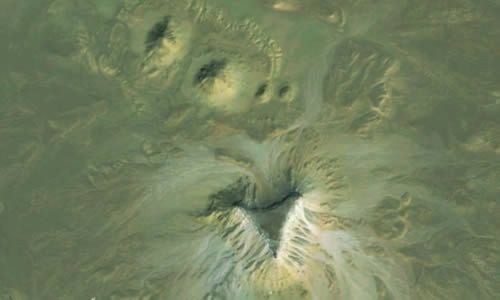Google Earth Probably Didn’t Just Find New Pyramids
Amateur archaeologist claims to have found lost pyramids using Google Earth. Real archaeologists are skeptical
Rather than setting out with an old, beat up map, a whip, and some wacky sidekicks to find ancient ruins, archaeologists might have recently found unknown Egyptian pyramids by sitting in front of their computers, browsing Google Earth. Indiana Jones would be rolling in his heavily booby-trapped grave.
Two sets of potential pyramids, located 90 miles apart, were found in northern Egypt. The images show some strange looking shapes jutting out of the desert in a vague formation. The press release describes them this way:
One of the complex sites contains a distinct, four-sided, truncated, pyramidal shape that is approximately 140 feet in width. This site contains three smaller mounds in a very clear formation, similar to the diagonal alignment of the Giza Plateau pyramids.
….
The second possible site contains four mounds with a larger, triangular-shaped plateau. The two larger mounds at this site are approximately 250 feet in width, with two smaller mounds approximately 100 feet in width. This site complex is arranged in a very clear formation with the large plateau, or butte, nearby in a triangular shape with a width of approximately 600 feet.
Here’s what one of the sites looks like:

These potentially hidden pyramids were discovered by Angela Micol, an amateur satellite researcher from Maiden, North Carolina. But Micol isn’t an expert. At MSNBC they spoke with Sarah Parcak, someone who is an expert, and whose use of satellite imagery helped her discover 17 lost pyramids, 3,100 ancient settlements and about 1,000 tombs last year. She told the site:
These Google Earth reports are coming from someone who is neither an Egyptologist, an archaeologist, or a remote sensing specialist, and from an area where there is no earthly reason to have a pyramid — 8 miles to the west of the Nile Valley edge in upper Egypt. … I get emails constantly from people who have claimed to find features.
Micol did ask an Egyptologist for their advice on the images, according to the press release, who said she might be on to something. Less than one percent of Egypt has been excavated, so there are almost certainly ruins we haven’t found yet.
Of course, earlier this year people thought they found Atlantis on Google Maps. Turns out it was a computer glitch. And it’s not the first time amateur archaeologists have “discovered” things that might not be real. A few years ago, Smithsonian Magazine traveled to Bosnia, where Sam Osmanagich believes he’d found a pyramid as well:
Not just any pyramid, but what Osmanagich calls the Pyramid of the Moon, the world’s largest—and oldest—step pyramid. Looming above the opposite side of town is the so-called Pyramid of the Sun—also known as Visocica Hill—which, at 720 feet, also dwarfs the Great Pyramids of Egypt. A third pyramid, he says, is in the nearby hills. All of them, he says, are some 12,000 years old. During that time much of Europe was under a mile-thick sheet of ice and most of humanity had yet to invent agriculture. As a group, Osmanagich says, these structures are part of “the greatest pyramidal complex ever built on the face of the earth.”
There’s a whole website dedicated to weird things people see on Google Earth called Google Earth Anomalies. There, Micol posted about her pyramids. Commenters, of course, had their own take on things. One of them thinks they aren’t pyramids at all:
Looks to me more like the sand dunes have moved into the area and the local people were intent on saving some of the sites soon to be covered by sand. So they have kept up and excavation of this area for a reason. Looks to be something round sitting on top of a square feature. I think it may be an old well, like a lot of these features usually are. Or at least some sort of religious site that is being kept open by the locals.
Another commenter thinks the images looks eerily similar to those of the surface of Mars.
Other archaeologists agree that just because something looks kind of funny on Google Earth doesn’t mean that it’s a lost pyramid. But Micol is pretty convinced it’s worth checking out. She said in the press release:
The images speak for themselves. It’s very obvious what the sites may contain but field research is needed to verify they are, in fact, pyramids and evidence should be gathered to determine their origins. It is my hunch there is much more to these sites and with the use of Infrared imagery, we can see the extent of the proposed complexes in greater detail.
The only way to find out, is to go.
More from Smithsonian.com:
Ancient Pyramids Around the World
The Mystery of Bosnia’s Ancient Pyramids
/https://tf-cmsv2-smithsonianmag-media.s3.amazonaws.com/accounts/headshot/Rose-Eveleth-240.jpg)


/https://tf-cmsv2-smithsonianmag-media.s3.amazonaws.com/accounts/headshot/Rose-Eveleth-240.jpg)